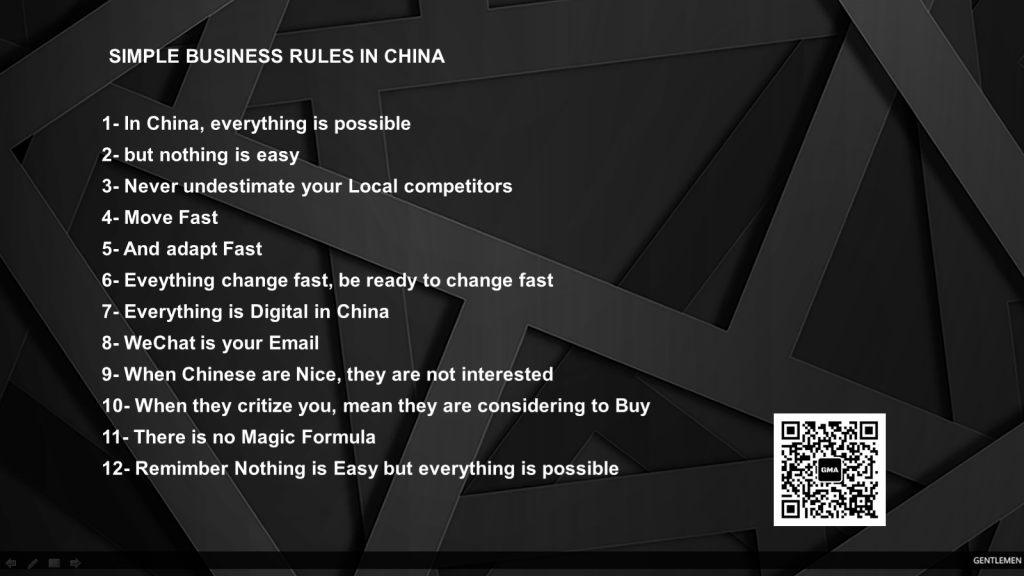Doing Business in China : 10 tips for SME

Cost-Effective Agency
KPI and Results focused. We are the most visible Marketing Agency for China. Not because of huge spending but because of our SMART Strategies. Let us help you with: E-Commerce, Search Engine Optimization, Advertising, Weibo, WeChat, WeChat Store & PR.
China is a US$10trn country that is growing at an astounding 7% per year. Are you interested in doing business in China and eat a part of this big cake?
China is not as easy as you might imagine.
Companies often mistakenly believe that they can jump into the Chinese market without adapting to their marketing strategy. The truth is that the China market will not accept any of the old techniques. It is important to spend time in a market to understand what customers want.
Adapt to the local market
Here’s a new generation Chinese who have studied abroad and are fluent in English. Although they might not know the latest business terminology or be fluent in western business jargons, it can be a refreshing change to speak plain English with Chinese colleagues.

China is a sophisticated market
You might be wrong if you think there is a shortage of disposable income on the Chinese market. It’s expected that 76% of China’s population will be middle-class by 2022. This is a significant number of new potential customers.
While you can read as much as you like and do online searches, nothing compares to visiting the area in person. However, many brands believe that the lessons from the West can be applied to Chinese marketing. Both markets have different needs. Success is about testing early with minimal financial resources, and adapting quickly to your learning.
Solve the distribution problem
China can be difficult to access due to the lack of local distribution networks, the buying habits of local consumers, and regulatory requirements. It is also difficult to get started because the market environment in China is so different from other countries. According to estimates, 37% of products that fail on the US market end up in China.
The perception that the Chinese are western copycats in tech is changing rapidly. China’s companies are gaining ground and giving Silicon Valley a tough time with strong GDP growth and increased government support. It’s a country that is more open to new ideas than ever.
find agents, distributors is a big challenges for western brands in China
China’s laws and regulation
China’s laws and regulations can be a problem for overseas companies, as 31% of 338 respondents to a business survey stated that bureaucracy was their biggest concern when they expand into China. Many respondents complain about the difficulty in obtaining licenses and permits.
Many Chinese companies seek to improve the quality and sell their products abroad. This has led to increased competition. In some cases, customers can also choose to support local companies over foreign ones. It is possible for the government to give preference to local firms. This makes it difficult to disrupt the market.
Internet : it is the best place to focus your effort
Chinese internet users access the Internet most of the time via their smartphones. China Internet Network Information Center (CNNIC’s) most recent report shows that there are 649 million internet users in China. 85% of these users access the Internet via their smartphones (+ 11% over years). Many companies want to grab a slice of the Chinese market. Marketing in China, however, is very different to marketing in Western countries.

E-Commerce the best way to sell in China
You need to be cautious as the online shopping environment is different in China than in any other country. JD.com or TMall are better options than creating your own eCommerce website if you are interested in e-commerce. These platforms allow you to access multiple brands at once. Alibaba claims that 54% of online shoppers use TMall. TMall is a B2C platform that is exclusively dedicated to brands. It has attracted many western retailers to use it as a marketing platform to increase sales and speed up their websites.
China’s business needs online communication
Nearly every Chinese social media platform has a mobile app that gives users instant access to their content from their phones.
Chinese influencers, known as KOLs (Key Opposition Leaders), have a huge clout and can be a great way to get exposure on social media.
Follow China national plan
China’s 14th Five Year Plan 2020 will mark the end of China’s 13th Five Year Plan. The 14th Five Year Planning period (2021-2025), which is the transition period that China needs to go from being a relatively prosperous country to achieving socialist modernization, will see China move to the next stage of its development. The evaluation of the 13th Five-Year Plan’s mid-term results, along with the policies and guidelines regarding the 2025-2035 development goals, shows that the 14th Five-Year Plan will focus on high-level openness, improved business environment and regional coordination, people’s livelihood, innovative development and the ecological environment.
Strategic opportunities for Foreign investors
Foreign investors will have strategic opportunities if there is a higher level in opening up and a better business environment. The Foreign Investment Law of China (January 2020) has given strong guarantees for greater opening. It focuses on opening up the financial sector and the service industry. Expanding the opening of the service sector will enable the transition from a quantity-catching up to an innovation leading type. The pilot free trade zones, free trade ports and free trade zones, which offer favorable conditions for trade and investment, are important ways to promote high levels of openness. They will provide more opportunities for innovation in the trade of services, particularly digital services.
China’s government will promote and deepen competition neutrality by treating all market entities equally, including foreign-funded ones, in terms of access to financing and market accesses. The 14th Five Year Plan will focus on high-level opening, better business environment, regional coordinated growth, people’s livelihoods, innovation driven development, and the ecological environment.
China’s consumption upgrading China is experiencing a clear trend towards consumption upgrading. The total retail sales for consumer goods surpassed RMB40 trillion in 2019. The Engel coefficient was almost half of the average for high-income countries (about 28%), and the service consumption was nearly 50%. The boom of online retail businesses during the pandemic has driven retailers to invest more in information and digital technology. This has changed the consumer ecology. China’s economic growth has been driven by technological innovation. China will continue to emphasize “expanding domestic demande” and explore the reform of the supply mode. It will also accelerate the cultivation and integration of offline and online businesses.
More growth opportunities will be available through “Consumption sinking”, precision consumption, and delicate consumption.
China technology
China has transformed from a major technology user into a producer of technology, and technological innovation has become an important driver for China’s economic growth. The rapid penetration of new technologies such as 5G, big data and the Internet of Things, and cloud computing into every sphere of society and economy will accelerate the process of upgrading and transforming traditional industries. Advanced manufacturing clusters will give a boost to the national economy’s sustainable development and promote its high-quality development.
The government has completed the top level design of four major national strategies in the last five years. These include coordinated development of Beijing and Tianjin, development of Yangtze River Economic Belt and construction of Guangdong–Hong Kong–Macao Greater Bay Area and integration strategy for Yangtze River Delta. The GDP of Beijing and Tianjin, Hebei, Yangtze River Delta and Guangdong–Hong Kong–Macao Greater Bay Area amounted to RMB8.5 trillion, RMB23.7 billion, and RMB11.4 trillion respectively in 2019. This makes China the “engine” for economic development. The future will be a key to coordinated regional development. This will be achieved through the ecological protection and quality development of the Yellow River Basin.
China will accelerate the implementation of other regional strategies, such as West China Development and the Comprehensive Revitalization of Northeast China. The Rise of Central China. China is changing its urbanization strategies. The main forms of bearing development elements in China’s urbanization are now the central cities and urban agglomerations. The government is expected to improve support policies regarding land, household registration, transfer payment, as well as promote the integrated development urban infrastructure, industrial distribution and public services.
Read also







Looking for Chinese Real Estate developers to buy prime land in Kilimani and Karen Nairobi Kenya
My contacts are gnkommo@gmail.com and Mobile +254752164344